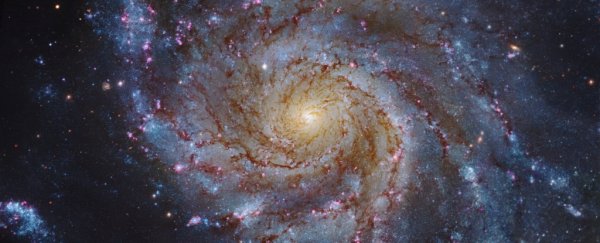There's a surprising amount of order in this chaotic Universe of ours, but this is a pretty weird one - astronomers have found that all galaxies, regardless of their size, take around one billion years to complete a full rotation.
This means that the material on the outer edge of a galaxy takes approximately one billion years to complete one orbit of the centre of the galaxy (in the Milky Way's case, that centre is Sagittarius A*, a supermassive black hole).
"It's not Swiss watch precision," explained lead researcher Gerhardt Meurer from the University of Western Australia branch of the International Centre for Radio Astronomy Research (ICRAR).
"But regardless of whether a galaxy is very big or very small, if you could sit on the extreme edge of its disk as it spins, it would take you about a billion years to go all the way round."
Interestingly, because all the stars in our galaxy orbit the centre at more or less the same velocity, objects closer to the centre of the galaxy don't take as long to orbit Sgr A*.
That's why a cosmic year - the time it takes for our Solar System to complete an orbit - is just 225 to 250 million years.
This is where the theory of dark matter comes from - because there simply isn't enough observable mass inside the Milky Way to account for this effect, unless we've profoundly misunderstood gravity, or there's mass we can't see.
The team's finding means that, for smaller galaxies, the material needs to move more slowly, since it has less distance to cover in the same amount of time.
The researchers measured the radial velocities of neutral hydrogen in around 130 galaxies, from small, irregular dwarf galaxies to enormous spiral galaxies. The range of galaxies spanned a factor of 30 in both size and velocity.
These measurements enabled the team to calculate the time each galaxy takes to complete a rotation - and all were more or less one billion years.
They also found a correlation between light distribution and atomic hydrogen at the galactic edge, allowing the team to confirm that their observation of the billion-year rotation was indeed occurring at the edges of the galaxies they studied.
And at these edges they found something else - older stars. Based on existing models, they expected to find mainly young stars populating galactic rims, but the older star population they found was a significant one, with a thin scattering of younger stars and interstellar gas.
"This is an important result because knowing where a galaxy ends means we astronomers can limit our observations and not waste time, effort and computer processing power on studying data from beyond that point," Meurer said.
"So because of this work, we now know that galaxies rotate once every billion years, with a sharp edge that's populated with a mixture of interstellar gas, with both old and young stars."
The team did note that their study may be subject to selection bias - that, out of all the galaxies in the Universe, maybe by chance they just picked ones that happened to show the same characteristics. Further study will be required to determine if the results are universal.
The team's paper has been published in The Monthly Notices of the Royal Astronomical Society, and can be downloaded here.
